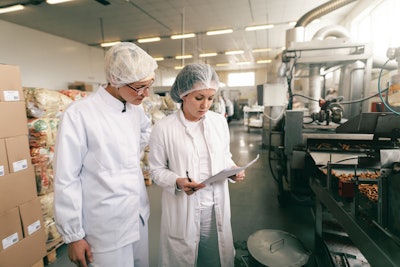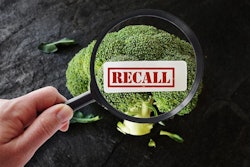
Ensuring food safety and quality and staying compliant with ever-changing regulatory requirements are chief business concerns for food and beverage manufacturers and processors.
Food and beverage companies are required to adhere to strict regulations in addition to achieving certain levels of certification. Some examples of groups and documentation that detail these regulations and certifications include:
• British Retail Consortium (BRC). The BRC Global Standards provides food retailers with a common approach to supplier auditing.
• FDA’s Code of Federal Regulations Title 21 (CFR). Title 21 is the portion of the Code of Federal Regulations that governs food and drugs within the United States for the Food and Drug Administration (FDA).
• Food Safety Modernization Act (FSMA). Signed into U.S. law in 2011, it was the first major overhaul to food safety legislation since 1938. The act covers all aspects of data capture, retention and inspection capabilities. The FDA is proposing to establish additional traceability recordkeeping requirements (beyond what is already required in existing regulations) for organizations that manufacture, process, pack or hold foods the agency has designated for inclusion on the Food Traceability List.
• Global Food Safety Initiative (GFSI). The GFSI is a private organization based in Belgium that maintains a scheme to benchmark food safety standards.
• Good Manufacturing Practice (GMP). GMP regulations are set by the FDA.
• Safe Quality Food (SQF). SQF is a rigorous and credible food safety and quality certification program recognized by retailers, brand owners and foodservice providers worldwide.
Processes and procedures must be in place to manage food safety and traceability, and to reduce the risk of costly food safety recalls or regulatory infractions. But, organizations also must have the flexibility to respond to changing regulatory requirements.
The ability to track products and ingredients both upstream and downstream—from raw ingredients to the finished goods and back—is imperative. Data from every point in the supply chain must be recorded to provide an audit trail. Modern enterprise resource planning (ERP) systems can help organizations succeed in this regard, and key capabilities in five key areas of focus will help food and beverage processors succeed:
Recipe management
Each recipe ingredient not only impacts the taste of the product, but also the nutritional value—a metric monitored strictly by numerous governmental regulatory agencies. A unique feature food and beverage processors need from their ERP system is the ability to identify specific nutritional values that result from the composition of a recipe; referred to as a Bill of Material (BOM). Think of this in terms of the nutritional label required on all food products.
For some companies, this is “simply” a matter of composing a formula and determining the nutritional values based on the ingredients in the formula. For others (further up the food chain), the companies must develop a formula based on target nutritional levels provided by their customers. This is a significantly more complicated exercise since different raw materials have different nutritional potencies and may react differently with various ingredients. To this end, food manufacturers use a combination of the BOM along with individual lot identifiers to determine variations across batches.
Formulation helps manage which ingredients are being used to create the product, meeting any requirement to calculate nutritional values that result from the formulation. Alternate and reverse BOMs assist manufacturers in quickly and efficiently identifying which raw materials can be substituted if an out-of-stock is encountered.
Alternate routings (how product moves though a facility) provide a means to pre-define multiple ways of manufacturing an item. These alternative ways can be driven by factors such as batch size, capacity of a work center, etc.
Another unique ERP feature used by food processors are automated unit of measure conversions (e.g., pounds to kilograms, each to case, milliliters to ounces). This assists with keeping inventory and recipes accurate, and with avoiding offline calculation or errors.
Examples of this include selling in a specific unit of measure (e.g., in pounds) vs. purchasing (e.g., in kilograms) vs. warehousing (e.g., in cases). The ERP system must be able to handle this level of recipe and formula management. Also important is what is referred to as a multi-level BOM or formulation (pre-blend added to a main blend), in addition to closely monitoring allergens and kosher item labeling requirements.
The ERP system must offer ways to monitor potency, volume and variable weights when developing formulas, as well as the ability to adjust formulas on the fly to account for concentration or natural product grade variations. Barcoding, in-line code readers and handheld technology is increasingly used to capture these complex transactions.
Inventory control
Inventory control addresses the visibility of material transfers, matching the physical movement of product between locations in as close to real time as possible in the ERP. It is particularly important for a food and beverage ERP solution to provide a record of where the product was located and when. For example, this could be used to trace back an allergen or other cross-contamination incident, giving the modern ERP user visibility to all materials that passed through and were potentially impacted by that location.
Some additional inventory tracking tools include:
• Lot control. The ability to trace raw materials from suppliers as well as finished goods to customers
• FEFO/FIFO. First expiration first out/first in first out
• Expiration date management of raw materials
• Shelf life or expiration date of finished goods
In addition to these items, kitting—the grouping together of a pre-defined group of items—is also a process that requires support from a modern ERP. The ability to create and track kits in a food and beverage ERP system is imperative to maintain traceability and reduce duplicate entry.
Planning and scheduling
Food and beverage manufacturers must consider multiple tasks when planning and scheduling manufacturing runs. For one, they need to have the ability to manage runs based on the many constraints, such as sequencing products containing allergens at the end of the shift and including time to changeover equipment that are unique to food and beverage production. A changeover occurs when the processor moves from making one product in a work center to another product. Sometimes this changeover could be as simple as washing down the machine. Frequently, however, it involves taking all the equipment apart and washing it down to sanitize it. Accounting for the time involved in these changeover activities as well as confirmation are often subject to above-mentioned documentation. An ERP solution must be nimble enough to accommodate these requirements.
Forecasting
Forecasting is important for many reasons, but especially for manufacturing companies to allocate an accurate budget. Food and beverage ERP solutions need to address this area while taking these issues into consideration:
• Seasonality. The demand for certain products changes with the seasons, and a food and beverage manufacturer must account for this fluctuation. Seasonality can also impact agricultural processors as their operations pivot around harvest.
• Customer forecasts. Manufacturers need to be aware of the forecast cycles of their customers to know how much of their product to produce. A right-fit ERP must integrate customer forecasts provided by the retailers into the processors planning engine. This helps keep processors ahead of the demand curve and anticipate peaks and valleys.
Empowered to succeed
Food safety, quality and compliance should always be top of mind with food and beverage processors. Having the right technological capabilities in place will aid organizations in minimizing risk, ensuring the right processes and procedures are in place and maximizing efficiency.


















